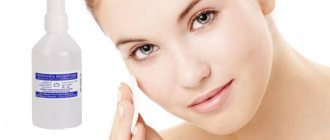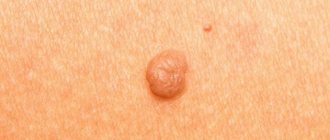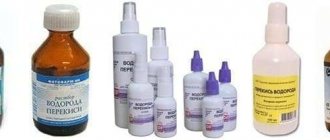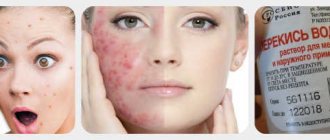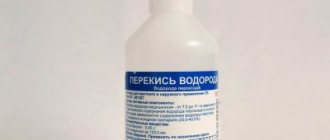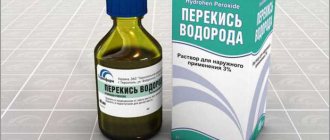Hydrogen peroxide for burns has an antibacterial and softening effect by mechanically cleansing the damaged area of the epidermis. The clinical picture develops instantly, so first aid must be provided as quickly as possible. The degree of damage depends on the size of the negative impact and the individual reaction of the affected skin. Peroxide can be used to treat burns for adults and children.
First aid is to eliminate symptoms and disinfect the wound. H2O2 is an inexpensive and safe antiseptic. If you follow the treatment recommendations, it helps the damaged dermis to quickly recover. When used correctly, it has almost no negative side effects, so this drug for treating burned skin has no age restrictions.
Composition and properties of the drug
A substance molecule is formed by 1 oxygen atom and 2 hydrogen atoms. The covalent bond between these elements is very weak. The hydrogen peroxide molecule is instantly destroyed when it interacts with the flow of light, air, blood, exudate and other organic substances.
Using hydrogen peroxide for burn injuries, the following therapeutic effects are achieved:
- normalize blood flow;
- eliminate swelling;
- disinfect wounds.
Hydrogen peroxide, when it comes into contact with burned skin, begins to foam and hiss. When interacting with biological substances, the substance breaks down with the formation of free oxygen radicals. Atomic oxygen instantly enters into biochemical reactions.
Hydrogen peroxide for burn injuries is used for the following purposes:
- washing, cooling and disinfecting the affected epithelium;
- suppression of the inflammatory process;
- cleansing epithelial tissues from pyogenic exudate, dead cells, and blood.
Contraindications
A burn is a serious injury to the skin, so when using hydrogen peroxide, be sure to take into account the recommendations and contraindications. In the following situations, treatment with the substance is prohibited:
- Allergy to the drug (individual intolerance).
- Burns 3-4 degrees.
- Skin dermatological pathologies.
- Do not pour antiseptic directly from the bottle into an open burn wound (use only lotions and compresses).
- Blisters caused by burns should not be punctured before applying peroxide.
- It is not recommended to apply hydrogen peroxide at a concentration higher than 0.5% to young skin (when the blisters burst, the epidermis is still thin and unformed - the drug will cause a chemical burn).
- Burns on the face or in the eye area cannot be washed with peroxide; there is a risk of the aggressive agent getting into the eye mucosa.
Helpful advice
Smearing burns with oily and greasy substances is strictly not recommended! Also, do not apply alcohol-containing solutions (green paint, iodine, vodka, etc.).
How to properly provide first aid for burns, watch Anton Kharchikov’s video.
Treatment of burn injuries with hydrogen peroxide
If a person is burned by boiling water, oil, contact with a hot object or chemicals, he needs emergency first aid and emergency treatment. For severe injuries, seek medical help.
In case of damage of 1-2 degrees, they act according to the following algorithm:
- Place the affected area under running cold water for 15 minutes. You can use ice. The bag with the cubes is wrapped in a towel and applied to the damaged area for 2-3 minutes. Direct application of ice and prolonged exposure to a cold compress leads to frostbite of injured tissues.
- Treat burned skin with an antiseptic, for example, hydrogen peroxide.
The drug is approved for use in the treatment of people of all ages. The solution is safe for children, pregnant and lactating women.
Hydrogen peroxide is allowed to treat mild lesions that do not require medical intervention. Small lesions are treated following the instructions:
- Injured skin tissues are washed with water.
- The napkin is moistened with a 1% peroxide solution (in case of a burn, you should not use the drug with high concentrations). Wrap the wound with a sterile bandage.
- The application is kept for 5-10 minutes.
- A new bandage is applied.
- After removing the last compress, allow the skin to dry, apply Levomekol ointment or other anti-burn agent to the burned tissue.
Hydrogen peroxide improves blood circulation in the affected area. Once on the surface of the epithelium, the drug breaks down the proteins of the dermis and activates blood clotting. As a result, the bleeding stops.
Properties of hydrogen peroxide
Treating a burn with peroxide is not the only way to use the drug correctly. Due to its oxidizing and reducing properties, it can be used as a bactericidal drug and antiseptic. Low cost in combination with beneficial properties make the drug used in the treatment of many diseases. Here is not the entire list of when H2O2 can be useful:
- disinfection of damaged surfaces;
- treatment of open wounds, scratches;
- treatment of ENT diseases;
- stopping nosebleeds;
- stopping capillary bleeding;
- preventing blood loss from scratches and abrasions.
Contraindications for use
Hydrogen peroxide is not used if you are hypersensitive to the drug. Allergic reactions occur in exceptional cases. The patient develops rashes, redness and itching on the skin. Allergies can develop into complications accompanied by the following symptoms:
- difficulty breathing;
- dizziness;
- fainting.
It is necessary to be careful not to get the antiseptic solution on the mucous membranes. The liquid causes a burning sensation and burns.
Vapors of highly concentrated peroxide when entering the nasopharynx can:
- burn the mucous layer of the nasal and oral cavity;
- cause swelling of the larynx;
- disrupt the functioning of the nervous system.
It is forbidden to smear hydrogen peroxide on fresh epithelial tissue formed under a burst blister. The solution will burn delicate skin.
Is it possible to wash a burn with peroxide?
No one is safe from burns.
There are four types: thermal, chemical, radiation and electrical. Before starting assistance, it is necessary to determine the type of damage and its degree:
- The first degree is the mildest: the skin may turn red and swell. All symptoms pass fairly quickly.
- Second: blisters are added to the symptoms of the first degree. On the second or third day, the blisters burst and skin restoration begins. It is impossible to burst such “burn” blisters, so as not to introduce an infection into the wound. Treating burns with second degree hydrogen peroxide is acceptable.
- Third: severe damage with blisters, possible tissue detachment. With this degree, you should not self-medicate; you must contact a burn center to see a combustiologist - a doctor specializing in burns.
- Fourth: the most dangerous degree, tissue death occurs. After damage, the skin turns black and peels off. Urgent hospitalization is required. Rinsing the burn with hydrogen peroxide at this stage will only cause harm.
To treat first and second degree burns, use a one percent peroxide solution. There is usually a 3% solution in the pharmacy; it can be diluted a little with water to reduce the concentration. Soak a bandage in peroxide, fold it several times, apply carefully, covering the surface of the injury. Leave this bandage for 10 minutes, then remove it, apply a healing ointment on top, and keep it on for several hours. The procedure must be carried out for several days. If there is no improvement, you should consult a doctor. If you treat a burn with hydrogen peroxide or Chlorhexidine, this will speed up the regeneration of damaged tissue, remove swelling and stop pain.
What is prohibited to do in case of burns
Burns will heal quickly if you follow certain rules. After receiving an injury, it is prohibited:
- Treat the wound with oil (vegetable, olive or any other), kefir or sour cream. Oily liquids do not bring relief and do not heal burned skin. The fatty film that appears on the surface prevents cooling of the wound.
- Soak the burn with herbal extracts and solutions containing ethanol. Some decoctions, antiseptics and alcohol tinctures increase pain and increase the affected area.
- Apply ointments, creams and sprays as soon as possible after injury . Fat-based preparations will give the same effect as vegetable oils. The wound surface will be covered with a dense film that does not allow air to pass through. The healing of the damaged area slows down, weeping spots form under the protective layer, and purulent exudate accumulates. First, the injured skin is cooled under a stream of water, then dried and treated with anti-burn agents.
- Pierce the burn. Intentionally opening the blisters leads to infection of the wound and complicates healing. Over time, the bubbles will spontaneously become smaller in size and open.
- Sprinkle the affected area with powdered agents: soda, starch, flour, talcum powder, baby powder. These substances do not provide any therapeutic effect in case of burn injuries; they are pointless to use for first aid and therapy.
Hydrogen peroxide, when used correctly and in compliance with the dosage, alleviates the condition of the victim and accelerates the healing of the lesion. The solution can be used to treat minor burns.
What concentration of hydrogen peroxide solution is useful for burns?
When buying first aid for burns in pharmacies, you should stop at a 1% solution. It is with this substance that you can effectively wash the burned area of skin and the areas adjacent to it. Soak a gauze pad folded in four with the solution and apply it to the burn. Pleasant coolness and a slight analgesic effect will do the trick. Skin sensitivity will be slightly reduced. But the benefits from such a stage are insignificant and short-lived. Similar lotions can be repeated several times before professional medical assistance is provided.
In addition, the burn is often combined with bacterial contamination. In this case, it is peroxide that will have a bactericidal effect and protect the open wound from infection. If there is no open surface in the wound, the cause of rot can also be microbes that live on human skin in the normal state. If the protective properties are weakened, they can provoke an infectious process.
But exceeding the concentration is unacceptable, since in this case the oxidizing properties will play a negative role - they will provoke a burn of soft tissues and destruction of cell membranes.
Can a burn be treated with hydrogen peroxide? It is possible, but not for the purpose of treatment or regeneration, but for temporary relief of the condition and a disinfectant effect on intact skin.
What should you watch out for?
Depending on the individual characteristics of the body, as a result of such primary treatment of a burn, a severe allergic reaction may develop, manifested in the spread of a reddened area, a feeling of itching, and in severe cases, a burning sensation in the eyes, difficulty breathing, and loss of consciousness.
Inhalation of high concentrations of peroxide can cause swelling and burns of the mucous membrane of the respiratory tract, and destabilization of the centers of the brain.
Skin reactions can also be hypertrophied: a violation of its physiological structure makes it vulnerable and susceptible to disease, interferes with normal trophism and respiration, and interferes with regeneration and recovery.
Is it possible to treat a burn with hydrogen peroxide and how to do it correctly
Burns from boiling water or steam are very common in everyday life. Correctly provided first aid helps prevent complications and speeds up recovery. Many people use improvised means that are found in every first aid kit to lubricate injured areas. Can a burn be treated with hydrogen peroxide? After all, this is one of the most accessible and inexpensive means.
Features of the treatment of burn injuries
After a severe burn occurs, it is necessary to rinse it with water as quickly as possible. This will reduce tissue temperature, preventing the development of blisters and damage to the deeper layers of the skin. It is best to use as cold water as possible or an ice compress.
Ice should not be applied directly to the skin - this can cause frostbite. It is recommended to pre-wrap it with soft cloth.
Only after the cooling procedure is completed can the burn be treated with any antiseptic or anti-inflammatory solution. Hydrogen peroxide is ideal for this purpose. This remedy has no serious contraindications and can be used for children, the elderly, and pregnant women.
Rules for use for 1st-2nd degree burns
Peroxide is not capable of burning the skin or causing further damage. But it is recommended to use it only for minor burns of 1-2 degrees of severity, when medical intervention is not needed.
If areas of necrosis form or a large area of the body is affected, you should not resort to the use of the drug.
In this case, it is necessary to consult a doctor as soon as possible, who will select the optimal treatment tactics.
The procedure for using hydrogen peroxide is as follows:
- The skin is cooled under running cold water to reduce the temperature of damaged tissues.
- A gauze pad or cotton swab is soaked in peroxide.
- The prepared fabric is applied to the wound for 10-15 minutes. You should not smear it too intensively, so as not to injure the skin.
- This manipulation can be performed several more times to achieve a better result.
- After the skin surface has dried, you can use special antibacterial ointments, for example, Levomekol. External agents are used together with fixing bandages several times a day. Such a treatment regimen will speed up recovery and prevent bacterial infection of injured areas of the body.
Recommended drug concentration
For burns, do not use hydrogen peroxide, the concentration of which exceeds 1%. If you do not adhere to this recommendation, even greater injury to the epidermis will occur, which will significantly worsen the person’s condition.
A medicinal solution of low concentration will ideally cope with its task. It disinfects, eliminates swelling and stops the development of the inflammatory process.
